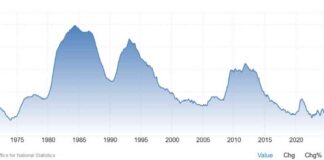Major Wall Street indices kicked off the week with a positive note, driven by optimism surrounding a potential “soft landing” for the economy. Investors seemed hopeful as US unemployment figures showed improvement, buoying confidence in the market.
Despite the overall positive sentiment, concerns lingered regarding the growing gap between full-time and part-time workers. This divergence has historically been a precursor to economic downturns, as highlighted in a research note by ING think.
Market participants are currently pricing in a 25 basis points cut by the Federal Reserve at the upcoming September meeting. While concerns over inflation data from China surfaced, the focus shifted towards tomorrow’s import and export numbers to gauge market sentiment.
In early trading, some notable movers included Boeing, which saw a 4.7% increase after reaching a tentative agreement with a US Pacific NorthWest union, potentially averting a critical strike. Dell and Palantir also experienced positive movements, with Palantir surging around 8% and Dell up by approximately 5.9%.
Looking ahead, upcoming economic indicators such as the US Producer Price Index (PPI) and Consumer Price Index (CPI) are on the horizon. However, these reports are not anticipated to significantly impact the Fed’s decision-making process, with the focus primarily on labor market data as a gauge for potential rate cuts.
As the market navigates through historically turbulent months for US stocks, questions arise about the recent selloff and the potential for further market corrections post the Federal Open Market Committee (FOMC) meeting on September 18.
### Market Analysis
#### S&P 500 Technical Outlook
The S&P 500 index faced its worst week since March 2023 but showed signs of recovery at the beginning of the week. Finding support around the key level of 5390 (July 25 low), the index hinted at a potential bullish inside bar or engulfing candle close, signaling further upside.
Despite the positive momentum, significant headwinds persist, underscoring the need for caution. Immediate resistance levels are seen at 5500 and 5538, with support resting at 5390 and 5330. The 100-day Moving Average (MA) at 5421 could provide additional short-term support.
#### Nasdaq 100 Technical Analysis
The Nasdaq 100 mirrored the S&P 500’s rally, gaining over 330 points since the market open. While a slight pullback was observed, historical trends suggest a potentially volatile period ahead, given September’s historical performance.
Following support around the 200-day MA at 18241, the Nasdaq 100 faces resistance levels at 18800 and 19000, with the 100-day MA at 19000 acting as a key level. Downside risks include breaching the 200-day MA and testing levels around 18000, 17800, and 17330.
### Market Sentiment and Outlook
With ongoing uncertainties in the market, investor sentiment remains cautious despite the recent uptick. While signs of economic recovery and potential rate cuts provide some optimism, underlying concerns such as labor market disparities and global economic indicators warrant vigilance.
As market participants navigate through a volatile period, staying informed about key economic data releases, central bank decisions, and geopolitical events will be crucial in making informed investment decisions. The upcoming weeks are likely to be pivotal in shaping market trends and determining the trajectory of major indices.
In conclusion, while the current market conditions show signs of optimism, investors should remain vigilant and adapt to evolving economic landscapes. By staying informed, analyzing key data points, and assessing risk factors, investors can navigate through uncertain times with greater resilience and confidence.

















